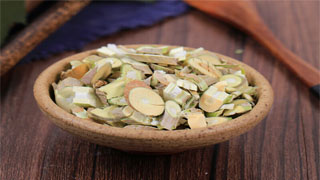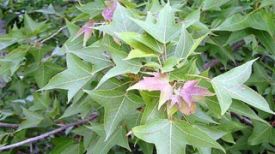
1. Aliases
Sangtiao.2. Plant morphology
Trees or shrubs, with a height of 3-10 meters or more, a diameter at breast height of up to 50 centimeters, thick bark, gray color, and irregular shallow longitudinal cracks; Winter buds are reddish brown, ovate, with scales arranged in a tiled pattern, grayish brown, and have fine hairs; Twigs have fine hairs. Leaves ovate or broadly ovate, 5-15 centimeters long and 5-12 centimeters wide, with acute, gradual, or blunt tips at the apex, circular to shallow heart-shaped at the base, serrated and rough edges. Sometimes the leaves are divided into various types, with a bright green surface and no hair. There are sparse hairs along the veins on the back, and clusters of hair in the axils of the veins; Petiole 1.5-5.5 cm long, with pubescence; Stipules lanceolate, early deciduous, densely covered with fine hard hairs on the outside. Flowers unisexual, axillary or born in the axils of bud scales, arising simultaneously with leaves; Male inflorescence drooping, 2-3.5 cm long, densely covered with white pubescence, male flowers. The perianth is wide elliptical in shape and light green in color. Filaments fold inward at bud stage, anthers 2-chambered, spherical to renal shaped, longitudinally split; The female inflorescence is 1-2 centimeters long and covered with hairs. The total peduncle is 5-10 millimeters long and covered with pubescence. The female flower has no stem, and the perianth segments are obovate. The top is round and blunt, and the outer and outer edges are covered with hairs. The ovary is tightly embraced on both sides, without a style. The stigma is 2-lobed and has papillary protrusions on the inner surface. Juhua fruit is oval shaped, 1-2.5 centimeters long, and is red or dark purple when mature. The flowering period is from April to May, and the fruiting period is from May to August.
3. Origin distribution
Born in hills, mountain slopes, villages, fields, etc., it is mostly artificially cultivated. Distributed throughout the country.
4. Harvesting and processing
Harvest from May to June, sun dry slightly, cut into 30-60 cm long sections or diagonal pieces while fresh, and sun dry.
5. Characteristics of medicinal herbs
The tender branches are long and cylindrical, with few branches and varying lengths, with a diameter of 0.5-1.5 centimeters. The surface is grayish yellow or yellowish brown, with many yellowish brown punctate pores and fine longitudinal stripes, and there are grayish white slightly semi-circular leaf scars and yellowish brown axillary buds. Durable and not easily broken; Cross section fiber. Slices are 0.2-0.5 centimeters thick, with thin skin, yellowish white wood, radiating rays, and white or yellowish white pulp. Slight breath, light taste.
6. Nature, taste, and meridian tropism
Mild in nature and bitter in taste. Guigan Meridian.
7. Effect and function
Dispel wind and dampness, unblock meridians, and promote the circulation of water and qi. It belongs to the category of regulating qi medicine.
8. Clinical applications
Internal administration: decoction, 15-30 grams. External use: Boil water and smoke wash. Indications: Rheumatism and pain, hemiplegia after stroke, edema and athlete's foot, and itching of the body.
9. Pharmacological research
1. Improve immune function: For patients with low lymphocyte transformation rate, taking 30g of mulberry branch decoction daily for one month can significantly improve lymphocyte transformation rate. Young mulberry branches have better therapeutic effects, while white mulberry leaves are ineffective.
2. Anti inflammatory effect: Both high and low dose groups of mulberry branches significantly inhibit the ear swelling caused by croton oil in mice, and can significantly inhibit the permeability of abdominal capillaries in mice. Diagonal carrageenan causes foot swelling in mice, while mulberry branches only show inhibitory effect at the second hour, with an inhibition rate of 28%
10. Chemical composition
Mulberry branches contain tannins, sucrose, fructose, stachyose, glucose, maltose, raffinose, arabinose, and xylose. The stem contains flavonoid components such as morin, quercetin, cycloquercetin, and quercetin. Wood contains mulberry pigment, zeaxanthin, 2,4,4 ', 6-tetrahydroxybenzophenone, 2,3', 4,4 ', 6-pentahydroxybenzophenone; Containing dihydromulberry pigment, dihydrokaempferol, 2, 4, 3 ', 5' - tetrameric glutinous rice, white mulberry alcohol.
11. Taboos for use
Pregnant women should avoid taking mulberry branches, and those who drink cold drinks to restrain their lungs should not take them.
12. Compatibility prescription
① Treating wind heat and arm pain: A small rise of mulberry branches. Cut finely, stir fry until fragrant, add three liters of water, and fry for two liters. A day's service is endless. (Our Party)
② To treat edema, one cannot sit or lie down, and the head, face, and body are swollen. Take a mulberry branch from the east and boil it with ash and juice, then boil red beans. Hollow food makes you full, hunger makes you eat up, do not eat or drink. (Mei Shi Fang)
③ To treat chronic cough, excessive phlegm and shortness of breath, persistent pus and blood in the saliva: file the mulberry strips fine, boil the juice and take it. (Hygiene Simplified Formula)
④ Treating internal and external obstacles, as well as cloudy membranes, red veins, and dullness: Mulberry branches (those tender in February and March) are dried and burned inside the purifier, causing the fire to self extinguish and turn into white ash. Previous flavor, carefully studied. Every time a three cent dagger is used, it is placed in a porcelain or silverstone vessel and soaked in boiling soup. After turning, it is ready to clear. If it is clear, it is poured into another vessel and further clarified. It is then filtered with new cotton, and if it is extremely clear, it is placed in a heavy soup to heat up. Open your eyes and rinse daily. (The Eye Wash Recipe in the Records of Saint Ji)
The content of the article is for clinical reference only. Non professionals in traditional Chinese medicine are not allowed to try medication.


